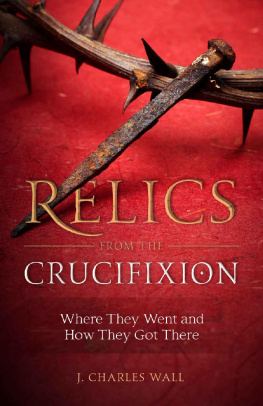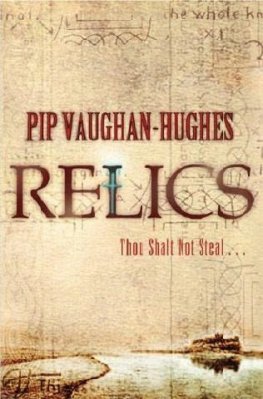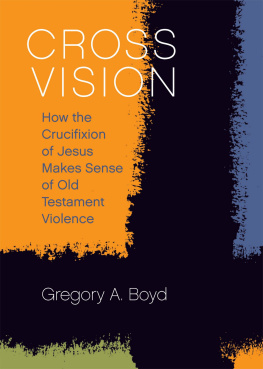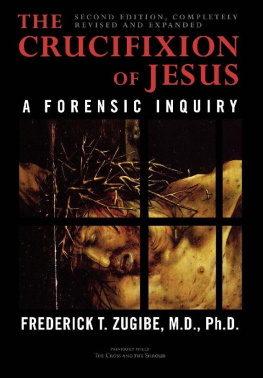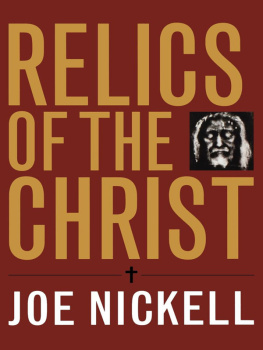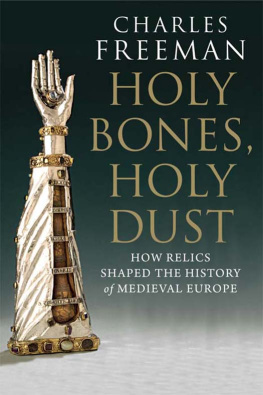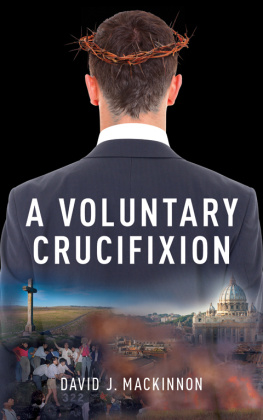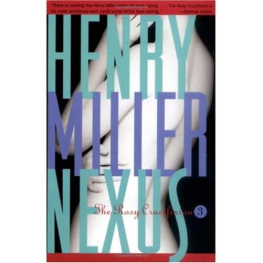J. Charles Wall - Relics from the Crucifixion
Here you can read online J. Charles Wall - Relics from the Crucifixion full text of the book (entire story) in english for free. Download pdf and epub, get meaning, cover and reviews about this ebook. year: 2015, publisher: Sophia Institute Press, genre: Religion. Description of the work, (preface) as well as reviews are available. Best literature library LitArk.com created for fans of good reading and offers a wide selection of genres:
Romance novel
Science fiction
Adventure
Detective
Science
History
Home and family
Prose
Art
Politics
Computer
Non-fiction
Religion
Business
Children
Humor
Choose a favorite category and find really read worthwhile books. Enjoy immersion in the world of imagination, feel the emotions of the characters or learn something new for yourself, make an fascinating discovery.
- Book:Relics from the Crucifixion
- Author:
- Publisher:Sophia Institute Press
- Genre:
- Year:2015
- Rating:5 / 5
- Favourites:Add to favourites
- Your mark:
- 100
- 1
- 2
- 3
- 4
- 5
Relics from the Crucifixion: summary, description and annotation
We offer to read an annotation, description, summary or preface (depends on what the author of the book "Relics from the Crucifixion" wrote himself). If you haven't found the necessary information about the book — write in the comments, we will try to find it.
Relics from the Crucifixion — read online for free the complete book (whole text) full work
Below is the text of the book, divided by pages. System saving the place of the last page read, allows you to conveniently read the book "Relics from the Crucifixion" online for free, without having to search again every time where you left off. Put a bookmark, and you can go to the page where you finished reading at any time.
Font size:
Interval:
Bookmark:
J. CHARLES WALL
Relics
from the
Crucifixion
Where They Went and
How They Got There
SOPHIA INSTITUTE PRESS
Manchester, New Hampshire
Copyright 2015 by Sophia Institute Press
Relics from the Crucifixion was originally published in 1910 by Talbot, London, under the title Relics of the Passion . This 2016 edition by Sophia Institute Press includes minor revisions.
Printed in the United States of America. All rights reserved.
Cover design by Perceptions Design Studio.
On the cover: Crown of thorns and nail (192988607)
Vasileios Karafillidis / Shutterstock.com
Unless otherwise noted, biblical references in this book are taken from the Catholic Edition of the Revised Standard Version of the Bible, copyright 1965, 1966 by the Division of Christian Education of the National Council of the Churches of Christ in the United States of America. Used by permission. All rights reserved.
No part of this book may be reproduced, stored in a retrieval system, or transmitted in any form, or by any means, electronic, mechanical, photocopying, or otherwise, without the prior written permission of the publisher, except by a reviewer, who may quote brief passages in a review.
Sophia Institute Press
Box 5284, Manchester, NH 03108
1-800-888-9344
www.SophiaInstitute.com
Sophia Institute Press is a registered trademark of Sophia Institute.
Library of Congress Cataloging-in-Publication Data
Names: Wall, J. Charles (James Charles)
Title: Relics from the Crucifixion : where they went and how they got there /
J. Charles Wall.
Other titles: Relics of the Passion
Description: Manchester, New Hampshire : Sophia Institute Press, 2016. |
Originally published under title: Relics of the Passion : London : Talbot,
1910. | Includes bibliographical references.
Identifiers: LCCN 2015039229 | ISBN 9781622823277 (pbk. : alk. paper) ePub ISBN 978-1-622823-284
Subjects: LCSH: Jesus Christ Crucifixion. | Relics.
Classification: LCC BT465 .W35 2016 | DDC 232.96/6 dc23 LC record available at http://lccn.loc.gov/2015039229
Contents
Relics from the Crucifixion
The origin of the True Cross we cannot pretend to know, although it has frequently been accounted for in the romantic legends of all ages and Western nations during the Christian era. Its intermediate history, difficult to preserve through periods of semibarbarity, has been rendered still less trustworthy by the fabulous stories of itinerant pardoners of the Middle Ages, who have done so much to confuse true relics with false that there are comparatively few that can be relied on. Except for a few fragments, the chief of these relics (the Cross) is lost, lost in the very efforts aimed at its preservation.
The wood of the Cross, however, forms such an integral part of the history of Christendom, and of those nations at one time adjoining her eastern limits, that the greatest skeptic cannot but acknowledge its influence. Whether it was the actual wood on which Christ died or a premeditated fraud of the emperor Constantine (c. 275-337) for political motives in no way alters the power it exercised.
The finding of the Cross immediately affected the Roman Empire, and a little later the whole of Europe, not only in religion and politics, but in literature and all branches of art. It has stirred mens minds as no other one thing has ever done, except the Divine Sacrifice. It created a fervor among Christians unknown and unequaled by any of the faiths of the world, not even excepting that of the Muslim. The Cross became the standard, not only of a creed, but of nations.
What if the whole story of the finding of the Cross was a fabrication?
This question is forced upon us when very many of our countrymen assert that such is the case. To determine this is no easy matter; much depends on the individual opinion of Constantines character, his aims, and the state of the times.
Belief in the gods was fast decaying. Faith in them was almost dead, and, generally speaking, men possessed no religion. The Christians, although yet a very small minority, were growing in numbers and not to be ignored. They were a people knit together by a great invisible bond, whose courage had been proved in the arena, their loyalty on the battlefield and in the camp. Those who had shown a firmness exemplary even in the Roman army and whose honor had become proverbial, would naturally be appreciated by a wise general, even though members of a despised sect.
Constantine had doubtless learned from his mother, Helena (c. 246-c. 330), the high ideal of the Christians life, even though he had not embraced the Faith. We know not how far St. Helena influenced him, but where there had once been persecution and oppression, under his rule there was free exercise of conscience. Although as yet he was not professedly a convert to Christianity, the faith of his mother had to a great extent worked into his soul, which, if not sufficiently grasped to control his passions, greatly guided his edicts.
Whether from political motives or not, we find the emperor recounts to Eusebius (c. 260-c. 340), bishop of Caesarea, a vision he professed to have had, in which the Cross was shown to be the symbol by which to conquer.
To conquer by the Cross! By the object of detestation to all Romans, concerning which Cicero says, Let the very name of the cross be absent not only from the bodies of Roman citizens, but also from their thoughts, their eyes, their ears. By the instrument of punishment for slaves and felons, not only of the Romans, but also among Greeks, Carthaginians, Egyptians, Persians, and Assyrians. How utterly beyond the comprehension of the peoples of the empire, yet in the face of all this Constantine adopted that symbol as his standard!
The term labarum is usually applied to the new flag or standard of Constantine in contradistinction to its predecessors, but it would appear to have been no new name, for we read in Sozomen that Constantine commanded artists to remodel the standard called by the Romans labarum , to convert it into a representation of the Cross, and to adorn it with gold and precious stones. The labarum is thus described by Eusebius:
Calling together the workers in gold and precious stones he [Constantine] sat in the midst of them, and described to them the figure of the sign he had seen, bidding them represent it in gold and precious stones. And this representation I myself have had an opportunity of seeing. Now it was made in the following manner. A long spear, overlaid with gold, formed the figure of the cross by means of a piece transversely laid over it. On the top of the whole was fixed a crown, formed by the intertexture of gold and precious stones; and on this, two letters indicating the name of Christ, symbolized the Saviors title by means of its first characters, the letter being intersected by exactly in its center; and these letters the emperor was in the habit of wearing on his helmet at a later period. From the transverse piece which crossed the spear was suspended a sort of streamer of purple cloth, covered with a profusion of embroidery of most brilliant precious stones; and which, being also richly interlaced with gold, presented an indescribable degree of beauty to the beholder. This banner was of a square form, and the upright staff, the full extent of which was of great length, bore a golden half-length portrait of the pious emperor and his children on its upper part, beneath the trophy of the cross, and immediately above the embroidered banner.The Greek letters (chi) and (rho) form the monogram of the name , used in the earliest Christian symbolism for Christ; and in the illustration of the labarum, on the reverse of a coin of Constantine the Great, we see one of its first public representations.
Thus, the Cross supplanted the eagle in the imperial standard; otherwise it was the same as the old vexilium with the cloth fastened to the crossbar, although this also was embroidered with Christian symbols.
Next pageFont size:
Interval:
Bookmark:
Similar books «Relics from the Crucifixion»
Look at similar books to Relics from the Crucifixion. We have selected literature similar in name and meaning in the hope of providing readers with more options to find new, interesting, not yet read works.
Discussion, reviews of the book Relics from the Crucifixion and just readers' own opinions. Leave your comments, write what you think about the work, its meaning or the main characters. Specify what exactly you liked and what you didn't like, and why you think so.

